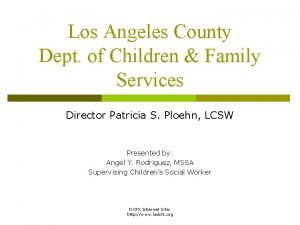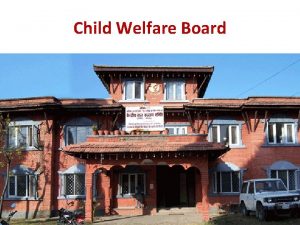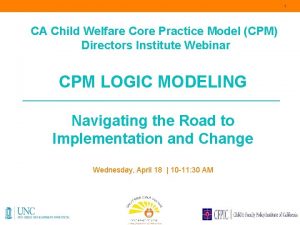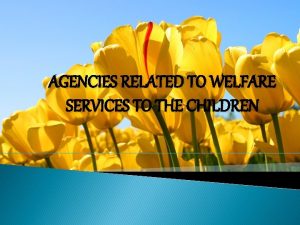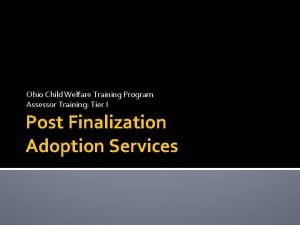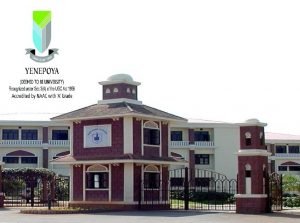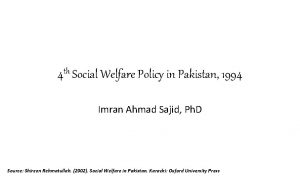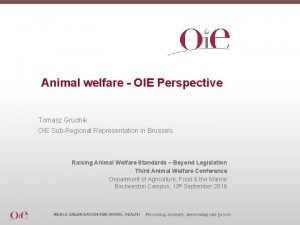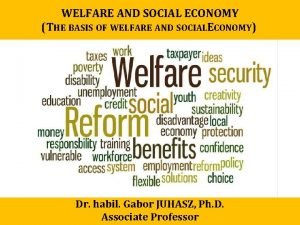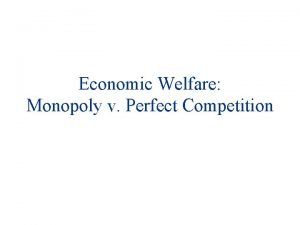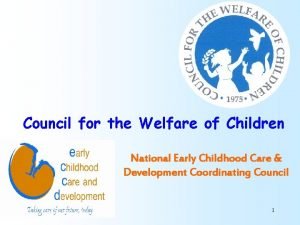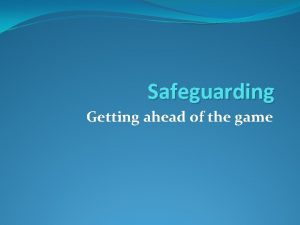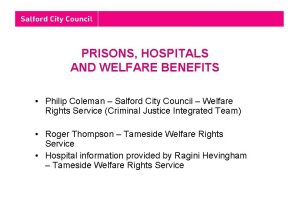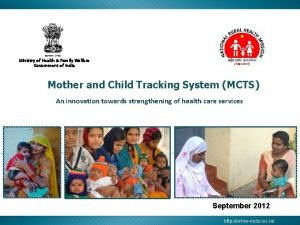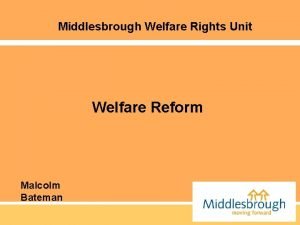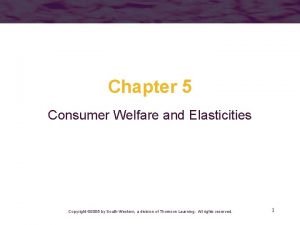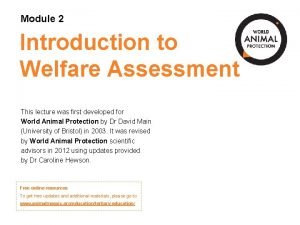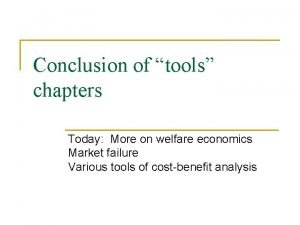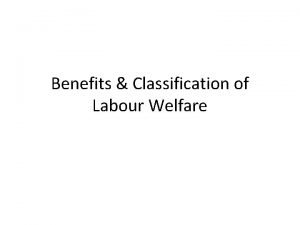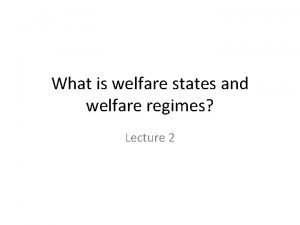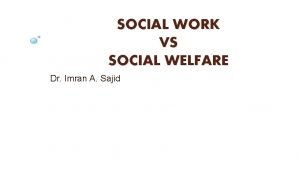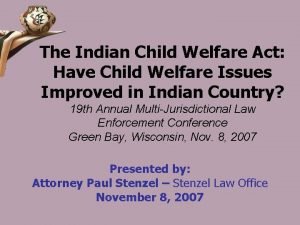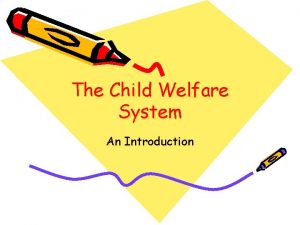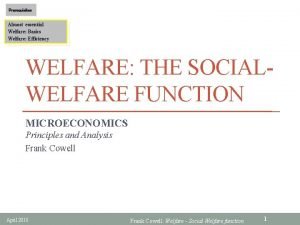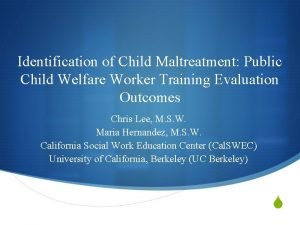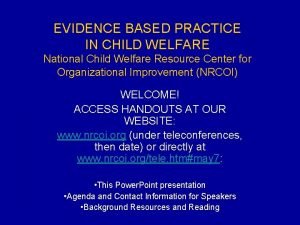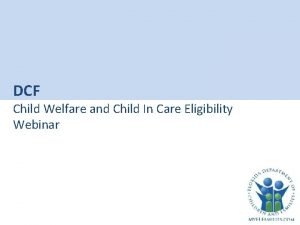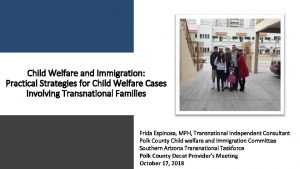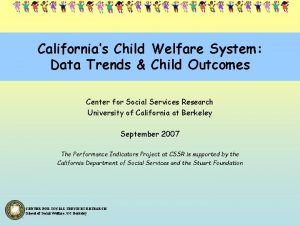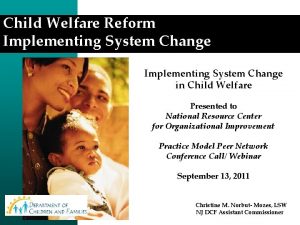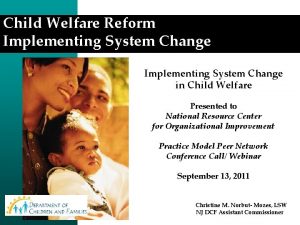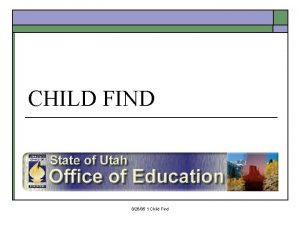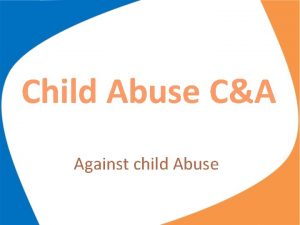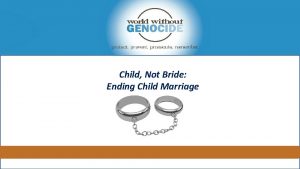Child welfare Child welfare Child welfare is a






























- Slides: 30

Child welfare

Child welfare �Child welfare is a term used to describe a set of government services designed to protect children and encourage family stability. �These services are designed to ensure that children are safe and that families have the necessary support to care for their children successfully.

Types of services �These typically include investigation of alleged child abuse and neglect (“child protective services”) foster care, adoption services, and services aimed at supporting at-risk families so they can remain intact ("prevention services" or "family preservation services").

Child welfare agencies �Child welfare agencies typically: �Support or coordinate services to prevent child abuse and neglect �Provide services to families that need help protecting and caring for their children �Receive and investigate reports of possible child abuse and neglect; assess child and family needs, strengths, and resources �Arrange for children to live with kin (i. e. relatives) or with foster families when safety cannot be ensured at home �Support the well-being of children living with relatives or foster families, including ensuring that their educational needs are addressed �Work with the children, youth, and families to achieve family reunification, adoption, or other permanent family connections for children and youth leaving foster care

Child protection �Child protection is a part of safeguarding and promoting welfare. This refers to the activity that is undertaken to protect specific children who are suffering, or are likely to suffer, significant harm. In law, the term 'significant harm' is central to any understanding of the state's powers to intervene in cases of child abuse. �The Children Act 1989 introduced the concept of significant harm as the threshold that justifies compulsory intervention in family life in the best interests of the children, and gives local authority a duty to make enquiries to decide whether they should take action to safeguard or promote the welfare of a child who is suffering, or is likely to suffer, significant harm.

Child welfare in the UK �The UK’s 4 nations – England, Northern Ireland, Scotland Wales – have their own child protection system and laws to help protect children from abuse and neglect. �Each nation has a framework of legislation, guidance and practice to identify children who are at risk of harm, and take action to protect those children and prevent further abuse occurring.

Child welfare in Britain �Read the text and answer the following questions: � 1. Who is primarily responsible for the upbringing of children? � 2. When does the State have a duty to intervene to safeguard the welfare of children? � 3. When did the Children Act come into force in Britain? � 4. What do some family centres provide?

Complete the text with the words below: consultation, authorities, parental, environment, recognised, bring up The family is the natural _______ for children. Where it is necessary, local _______ should provide services such as advice and counselling, holiday activities and family centres, to help parents to _____ their children in the home. These services should be provided in ________ and partnership with families. The parents are _______ as the best people to bring up their children. They retain _________ responsibility even when their children no longer live with them.

The duty of the state �The prime responsibility for the upbringing of children rests with parents and the vast majority of children do grow up in caring families. But where children are not receiving adequate care, the State has a duty to intervene to safeguard the welfare of those children. �Translate the above paragraph!

Abuse �Abuse and neglect are forms of maltreatment of a child. Somebody may abuse or neglect a child by inflicting harm, or by failing to act to prevent harm. Children may be abused in a family or in an institutional or community setting, by those known to them or, more rarely, by a stranger, for example, via the Internet. They may be abused by an adult or adults, or another child or children.

Types of abuse �Emotional abuse (the persistent emotional maltreatment of a child such as to cause severe and persistent adverse effects on the child's emotional development. It may involve conveying to children that they are worthless or unloved, inadequate, or valued only insofar as they meet the needs of another person). �Sexual abuse (forcing or enticing a child or young person to take part in sexual activities, including prostitution, whether or not the child is aware of what is happening). �Physical abuse (may involve hitting, shaking, throwing, poisoning, burning or scalding, drowning, suffocating, or otherwise causing physical harm to a child).

Neglect �Neglect is the persistent failure to meet a child's basic physical and/pr psychological needs, likely to result in the serious impairment of the child's health or development. Neglect may involve a parent or carer failing to provide adequate food and clothing, shelter, failing to protect a child from physical and emotional harm or danger, failure to ensure adequate supervision including the use of inadequate caretakers, or the failure to ensure access to appropriate medical care or treatment.

The Children Act 1989 �The Children Act 1989, which came into force in October 1991 in England Wales, provides a single coherent framework for the care, protection and upbringing of children. It addresses a wide range of situations, from what happens to children following divorce to protecting children from physical and sexual abuse, to the support of families with children in need.

From the Children Act 1989 Welfare of the child. E+W (1)When a court determines any question with respect to— (a)the upbringing of a child; or (b)the administration of a child’s property or the application of any income arising from it, the child’s welfare shall be the court’s paramount consideration. (2)In any proceedings in which any question with respect to the upbringing of a child arises, the court shall have regard to the general principle that any delay in determining the question is likely to prejudice the welfare of the child.

Children in need �The definition of children in need from the Children Act 1989: �Children with disabilities and those whose needs relate to social and economic deprivation

�Children in need are those whose vulnerability is such that they are unlikely to reach or maintain a satisfactory level of health or development, or their health and development will be significantly impaired, without the provision of services. Disabled children are also considered to be children in need.

The Convention on the Rights of the Child

The Convention on the Rights of the Child �The Convention on the Rights of the Child is a universally agreed set of standards and obligations which place children centre-stage in the quest for a just, respectful and peaceful society. �https: //www. youtube. com/watch? v=tes. GUxyd-lw �Translate the sentence!

Power of words �Right words, wrong order �https: //www. youtube. com/watch? v=tes. GUxyd-lw

Ratification �The Convention was agreed to on 20 November 1989 by the United Nations General Assembly and since then 194 States have ratified it. It is the most widely adopted international human rights treaty in history. �In Croatia, it has been in force since 8 October 1991

The definition of a child �The Convention defines a child as a boy or girl under the age of 18 and considers a child as both an individual, as well as a member of a family and a community. A child is a human being with the full range of rights. �Article 1 �For the purposes of the present Convention, a child means every human being below the age of eighteen years unless under the law applicable to the child, majority is attained earlier.

Principles �The Convention rests on four foundation principles: �non-discrimination (Article 2) �best interests of the child (Article 3) �the child’s right to life, survival and development (Article 6) �respect for the views of the child (Article 12)

Basic rights for all children �The right to survival �To develop to the fullest �To protection from harmful influences, abuse and exploitation �To participate fully in family, cultural and social life


Some results for children �In the years since the Convention was adopted, the world has seen concrete results for children. Between the early 1990 s and 2000, the average under-five mortality rate declined by 11 per cent, underweight prevalence among children under five fell from 32 per cent to 28 per cent in developing countries, and global access to safe drinking water rose from 77 per cent to 82 per cent. Child deaths from diarrhoea, the foremost killer of children at the beginning of the 1990 s, declined by half, saving an estimated 1 million lives.

Celebrating 25 years of the UNCRC �https: //www. youtube. com/watch? v=Owxa. IMj. G 04 w

UNICEF �UNICEF(The United Nations International Children's Emergency Fund) is governed by convention �Created by the United Nations General Assembly on 11 December 1946 �Headquarters in New York �UNICEF Goodwill Ambassadors

Match the collocations: provide child needs prevent services assess safety ensure children and families work with abuse and neglect

Translate the following: �Protection rights ensure children are safeguarded against all forms of abuse, neglect and exploitation, including special care for refugee children; safeguards for children in the criminal justice system; protection for children in employment; protection and rehabilitation for children who have suffered exploitation or abuse of any kind.

Thank you for your attention!
 Child welfare
Child welfare National program related to child health and welfare ppt
National program related to child health and welfare ppt Children and family services los angeles
Children and family services los angeles Vr3 child welfare foundation
Vr3 child welfare foundation National child policy 1974
National child policy 1974 Central child welfare board
Central child welfare board Cpm implementation
Cpm implementation International agencies for child welfare
International agencies for child welfare Ohio child welfare training program
Ohio child welfare training program List of child welfare agencies in india
List of child welfare agencies in india Left child right sibling
Left child right sibling 2nd social welfare policy in pakistan
2nd social welfare policy in pakistan Education welfare
Education welfare Microbes in human welfare
Microbes in human welfare Ra 9344
Ra 9344 Social solidarity meaning
Social solidarity meaning Perfect competition deadweight loss
Perfect competition deadweight loss Council for the welfare of children
Council for the welfare of children Lta welfare officer poster
Lta welfare officer poster Similarities between animal rights and animal welfare
Similarities between animal rights and animal welfare Welfare rights salford
Welfare rights salford Monopoly deadweight loss
Monopoly deadweight loss Nrhm-mcts.nic.in data entry
Nrhm-mcts.nic.in data entry Welfare rights middlesbrough
Welfare rights middlesbrough Cournot aggregation
Cournot aggregation Welfare inputs and outputs
Welfare inputs and outputs Conclusion of welfare economics
Conclusion of welfare economics Classification of labour welfare activities
Classification of labour welfare activities Example of remedial model
Example of remedial model What is welfare
What is welfare Social welfare vs social work
Social welfare vs social work


